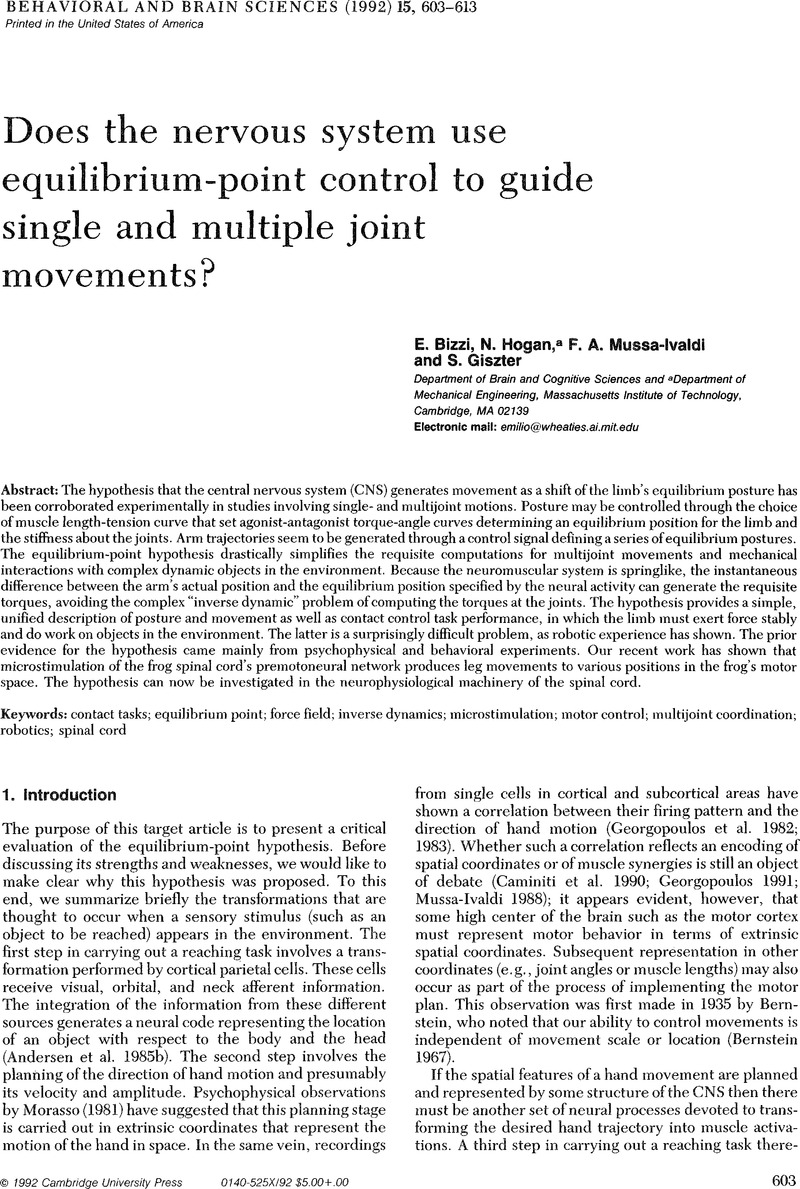Crossref Citations
This article has been cited by the following publications. This list is generated based on data provided by Crossref.
Latash, Mark L.
and
Zatsiorsky, Vladimir M.
1993.
Joint stiffness: Myth or reality?.
Human Movement Science,
Vol. 12,
Issue. 6,
p.
653.
Hatsopoulos, Nicholas G.
and
Warren, William H.
1995.
Do control variables exist?.
Behavioral and Brain Sciences,
Vol. 18,
Issue. 4,
p.
762.
Latash, Mark L.
1995.
Equilibrium-point control? Yes! Deterministic mechanisms of control? No!.
Behavioral and Brain Sciences,
Vol. 18,
Issue. 4,
p.
765.
Partridge, Lloyd D.
1995.
Let us accept a “controlled trade-off” model of motor control.
Behavioral and Brain Sciences,
Vol. 18,
Issue. 4,
p.
773.
Scott, Stephen H.
1995.
Can the λ model be used to interpret the activity of single neurons?.
Behavioral and Brain Sciences,
Vol. 18,
Issue. 4,
p.
778.
Pribram, Karl H.
1995.
Position is everything?.
Behavioral and Brain Sciences,
Vol. 18,
Issue. 4,
p.
776.
Smeets, Jeroen B. J.
1995.
Two joints are more than twice one joint.
Behavioral and Brain Sciences,
Vol. 18,
Issue. 4,
p.
779.
Goodman, Simon R.
1995.
Inverse kinematic problem: Solutions by pseudoinversion, inversion and no-inversion.
Behavioral and Brain Sciences,
Vol. 18,
Issue. 4,
p.
756.
Gielen, C. C. A. M.
and
van Bolhuis, B.
1995.
Reciprocal and coactivation commands are not sufficient to describe muscle activation patterns.
Behavioral and Brain Sciences,
Vol. 18,
Issue. 4,
p.
754.
Pagano, Christopher C.
and
Bingham, Geoffrey P.
1995.
Spatial frames for motor control would be commensurate with spatial frames for vision and proprioception, but what about control of energy flows?.
Behavioral and Brain Sciences,
Vol. 18,
Issue. 4,
p.
773.
Gottlieb, Gerald L.
1995.
Shifting frames of reference but the same old point of view.
Behavioral and Brain Sciences,
Vol. 18,
Issue. 4,
p.
758.
Patla, Aftab E.
1995.
The λ model: Can it walk?.
Behavioral and Brain Sciences,
Vol. 18,
Issue. 4,
p.
775.
Flanagan, J. Randall
Tresilian, James R.
and
Wing, Alan M.
1995.
Grip force adjustments during rapid hand movements suggest that detailed movement kinematics are predicted.
Behavioral and Brain Sciences,
Vol. 18,
Issue. 4,
p.
753.
Morasso, Pietro
and
Sanguineti, Vittorio
1995.
Kinematic invariances and body schema.
Behavioral and Brain Sciences,
Vol. 18,
Issue. 4,
p.
769.
Hamm, Thomas M.
and
Han, Zong-Sheng
1995.
Is λ an appropriate control variable for locomotion?.
Behavioral and Brain Sciences,
Vol. 18,
Issue. 4,
p.
761.
Bonnard, Mireille
and
Pailhous, Jean
1995.
A few reasons why psychologlsts can adhere to Feldman and Levin's model.
Behavioral and Brain Sciences,
Vol. 18,
Issue. 4,
p.
746.
Alexandrov, Alexey
Frolov, Alexander
and
Massion, Jean
1995.
Is the multi-joint pointing movement model applicable to equilibrium control during upper trunk movements?.
Behavioral and Brain Sciences,
Vol. 18,
Issue. 4,
p.
745.
Windhorst, U.
1995.
Levers to generate movement.
Behavioral and Brain Sciences,
Vol. 18,
Issue. 4,
p.
784.
Haggard, Patrick
Miall, Chris
and
Stein, John
1995.
Twisted pairs: Does the motor system really care about joint configurations?.
Behavioral and Brain Sciences,
Vol. 18,
Issue. 4,
p.
758.
Hodgson, Antony
1995.
The unobservability of central commands: Why testing hypotheses is so difficult.
Behavioral and Brain Sciences,
Vol. 18,
Issue. 4,
p.
763.


